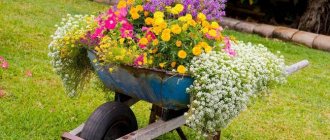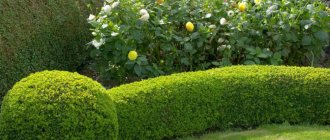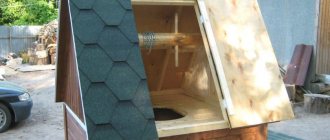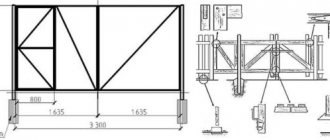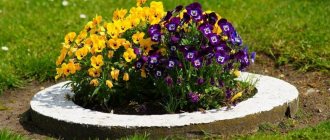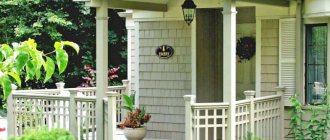Neat and beautiful flower beds are a wonderful decoration of the garden. They can be located in the garden itself, or along the path running from the gate to the house, and also serve as a kind of fence, marking the boundaries of the territory. Depending on the height of the flower beds, their shape, purpose, and your aesthetic preferences, you can use different materials and their combinations for fencing them.
For example, stone, concrete, brick, wood, tile, metal, glass, and ceramics. Recycled items such as dishes, wheels, tires, etc. are also suitable.
Our garden landscaping ideas here will help you gain inspiration and take your garden landscaping to the next level!
Concrete fencing
Concrete and stone fences are often very similar to each other, because an imitation of stone can be made from concrete. Thanks to this, you can make solid fencing walls from concrete, or lay them out from pieces, or make horizontal edgings of flower beds.
Read also the article “Hedges: what to plant?”
Here is one example of the arrangement of such flat stones made of “broken concrete” around the corner of a house.
It draws attention to the plants planted against the background of the wall of the house.
The following example shows how to make a low relief wall from concrete.
This design is very reliable and durable. It can also be painted or decorated in some other way, for example, by laying out a small mosaic.
Unusual fence made of plastic bottles
This option is considered creative. In addition, every person has plastic bottles for drinks and beer. Therefore, such a design will cost absolutely nothing. The only thing is that you will need to spend some free time.
When constructing an original fence from plastic bottles, preference is given to dark-colored containers (brown translucent). Because they are more practical. To create a fence, labels are removed from plastic bottles and for stability they are filled with small stones, earth or sand. Next, the bottles are buried around the perimeter of the flowerbed, half the neck down or up (here everyone decides for himself which installation method he prefers). Despite its primitiveness, such a fence looks quite original and interesting. It is suitable for both classic and modern garden design.
Brick fences
Bricks and pavers can be carefully laid around flower beds to create simple, neat patterns.
And here you can see ideas on how and what to decorate a fence at the dacha
For example, place one row horizontally and the other vertically.
And two more similar options:
Or this pattern, made of ordinary bricks. Each piece of the pattern consists of 4 bricks and a decoration in the middle.
As an additional decoration element, you can add lighting along the inside of the brick fence.
Thus, the flowerbed will look wonderful not only during the day, but also at night.
Bricks can also be laid at an angle, as in the next photo. The result is a jagged fence that creates a rustic look.
Flowerbeds can be located on both sides of the path in the garden, and in this case, it will serve as their fence.
To make it more unusual, you can experiment with the shape and make it wavy rather than straight.
And another option with brick:
Stepson rules
Two weeks after planting the seedlings, pinching is carried out. During this period, the plant grows by 5-7 cm, which indicates that they are ready for this treatment. Stepping is carried out in the morning. Carefully form a bush, removing the lower leaves, ovaries in the axils and additional stems. The treatment is carried out in such a way that the bush has a maximum of two good, thick stems. It is advisable to remove all other branches.
Attention: After pinching, the plants should not be watered for one or two days.
Further, for high-quality development, it is necessary to observe the correct feeding and watering regime throughout the entire period of tomato growth. Only in this case can a rich and high-quality harvest be achieved.
Share with friends 
3+
1
Metal fencing
Flowerbeds can be planted either at the level of the entire landscape or slightly raising them above it. When making an elevation, it is important that it is strong and secure, and holds the flowerbed in place. A material such as metal will cope with this task wonderfully.
Look, for example, at the following photo, in which a raised flowerbed is protected by a “rusty” metal winding. Simple and beautiful!
And here is another similar option, but here the fence goes in a zigzag, not in waves:
Corrugated steel panels can also be used. When combined with wood they create an interesting and modern design.
Palisade - a convenient miniature decoration
Small pegs will give the flowerbed a well-groomed appearance. They can be installed at the same level or arranged randomly:
- Sand small fragments of the picket fence, remove all roughness, and varnish.
- Leave to dry in the sun or fresh dry air. It is important not to leave uncured coating outside in wet weather.
- Meanwhile, draw a marking on the ground where you will drive in the planks. You can make an irregularly shaped edging. From the outside it will look unusual.
- Drive a picket fence around the flower bed, then adjust the height. It is important that it is the same on all sides. Then the design will take on a neat appearance.
In modern landscape design, the use of specially prepared boards with rounded corners and unusual shapes is encouraged. If you have carpentry skills, you can prepare figured or carved parts.
Decorating a flower bed with a decorative fence Source 7dach.ru
Stone fences
Stone is a very popular material for edging flower beds as it gives them a natural and natural look. Stones have many shapes, sizes, colors, and also differ in appearance and texture. This allows you to use whole stones for construction, or trimmed ones, as well as their combination for the desired result.
Gabion fencing
Gabion is great for fencing flower beds. It looks natural, yet structured, and blends well with the environment. It is also strong, reliable and durable.
The metal cage can be divided into sections (for example, by wooden partitions, as in the first example), or be integral. The size of the stones for filling the gabion and their shape can be very diverse, the main thing is that they do not fall out through the checkered fence.
Stacked Flat Edged Stones
One simple way to fence a flower bed is to use flat edged stones, laid out on top of each other around the flower bed in several layers.
Small pebbles
A small stone border can separate both a flowerbed and a lawn and a house and a lawn. To do this, you need to make a small depression along the border and fill it with small pebbles.
Packing crushed stone between bricks
This lawn fencing idea provides contrast with the brick and wide strip of crushed stones.
Here is another example of this use of small pebbles:
Here, pebbles of different colors were used to enhance the contrast of the border.
Stones combined with bricks
This fencing of smooth stones and bricks gives a very natural, not too “flawless” look. As you can see, there are no complicated instructions for installing rock landscaping, other than the fact that each stone will need to be lifted and put into place, and this requires a certain amount of physical strength.
Using stones of different sizes provides great contrast. Small stones create a nice transition border, while large stones form the main border and keep the flower bed raised slightly above the level of the lawn.
It is also possible to combine stones with sand, in which case it is as if you are creating a small piece of the beach in your garden.
And a few more options with stone:
And even marble:
Examples of borders and work on mistakes
Let's look at a few examples of fences made independently from scrap materials and figure out why they don't look as attractive as the pictures on the Internet. Let's arrange a review in the style: expectation - reality.
Flower bed made of glass bottles
Country websites have published many photographs with step-by-step instructions for making chic flower beds from glass bottles. They are installed in a row in the form of a fence, and laid on cement, making multi-colored multi-level borders. At first glance, the material is really not bad: it reflects beautifully in the sun, is accessible (you can find it in any bushes), and does not rot at all.
As a sample, we decided to make such a simple flowerbed, even simpler - a border between the flower bed and the path
Please note: in the picture, just like ours, the height of the soil in the flowerbed was higher than in the surrounding area. This was the main reason for the failure. The fact is that wet black soil becomes several times heavier , pressing with all its weight on the curb. And there is no support outside! As a result, the bottle fence bends outward, and the earth “leaks” onto the path. You have to constantly adjust, add drops, and deepen the bottles.
Once slender rows move at random
Our second mistake was choosing bottles of different sizes and shapes : together they look very sloppy. And you shouldn’t take white ones - condensation with dust accumulates inside the transparent glass and the result is dirt, which will undoubtedly give an unkempt appearance to the entire flowerbed.
How to fix
To get a beautiful border from glass bottles, in my opinion, you need:
- Choose the same dark “glass container” and wash it off the labels.
- Plug the necks to prevent dirt from getting inside.
- Make the level of the flower bed and the path around it the same.
- Secure the bottles to cement or secure them with crushed stone, and do not just dig them into the ground.
- Ideally, place a border strip inside the bed - this way the soil will not spill to the sides.
- Make a blind area or fill on the outside using geofabric, as in the example from the Internet, so that the weeds do not get inside, and the “inhabitants” of the flowerbed do not get out.
Bottle wall
Our next experiment was bottle stacking. There was just a bag of cement left from construction.
Having seen such a picture on one of the sites, we were inspired by the idea of building a similar flower bed against the wall
We collected a few bottles. Due to their small number, we had to make a brick base, and place a row of bottles on top for beauty.
To be honest, I was not pleased with the result.
Within a month, all the glass containers simply fell out of the cement “nests”
Why this happened, I don’t know. Can one of the readers tell me the reason?
But besides this, I was able to notice several errors in the layout of the wall bed, which I would like to draw attention to:
- when attaching a flowerbed to a wall, lay a layer of waterproofing so that moisture from the ground does not provoke the appearance of fungus on buildings;
- do not fill the bottom with cement, leave drainage holes - otherwise the bed will turn into a mini-pond;
- do not place such borders on the lawn that you plan to mow - pebbles from under the trimmer are great for breaking bottles;
- do not place bottles with the neck facing outward, otherwise the wind will whistle and howl in the holes;
- seal the necks to prevent soil and water from getting inside.
These are the experiments we conducted with glass containers on the site, unfortunately, they were not entirely successful. I hope you do better.
Fences made of wood and brick
Brick and wooden structures also found their place in our garden.
A board fence perfectly screens off fruit and berry and ornamental crops from the lawn
It’s very simple to create: you need to drive pegs into the corners and attach the boards to them with self-tapping screws. But you definitely need to cut off the weeds; they crawled inside under my fence.
The wattle fence, unfortunately, only looks beautiful for a couple of years
If at first the branches look as impressive as in the picture, then over time they become gray, break when touched awkwardly and become covered with fungus.
Low brick fences and stone fences must be placed on a substrate that cuts off weeds. In this case, both outside and inside it is necessary to use multilayer cardboard, special black fabric or border tape. If you simply lay the bricks on the ground, then by mid-summer you will have to lift each of them 20 times. Wheatgrass roots “dive” perfectly under such a border, and quinoa and bindweed simply “climb” over it.
The ubiquitous weed also crawled through the imitation stone cast from concrete directly on the ground.
As you can see, not everything that bed design specialists demonstrate is actually suitable for practical use and pleasing to the eye. I hope my examples will be useful to someone and help to avoid mistakes in fencing plantings.
Wooden fences
Wood, like brick and stone, comes in many forms. The most common type of fencing is the raised garden bed, but as you'll see, there are many more types!
Horizontal wooden beams
The beams are placed at angles to the fence and only one plant is planted in each “growing zone”. Also used here is a combination with decoration with small pebbles.
Vertical wooden beams
Such beams, cut to different lengths, make the fence a little chaotic and give it uniqueness.
Here's another example where the beams are already aligned to the same length:
You can also add original decorations, such as “stone legs”, or anything else interesting that you want!
Small fence
Fencing a flower bed in the form of a miniature fence is very simple to do, but it looks interesting and funny. The boards can be simply varnished, painted plain, or a combination of different colors. The fence can be smooth, or consist of boards of different lengths.
Or here’s another example of a small fence made from old pallets:
Chopped trees
Wood can be used as a fence even in its most natural form, that is, using tree trunks or their thick branches.
And a few more options for using wood:
Flower row
There is a mobile version of a fence for a flower bed - pots planted with ornamental plants. It looks like a multi-tiered discount due to the use of several types of different crops at once.
Everything is simple and clear here:
- We take garden pots of the same size.
- We cover it with earth.
- We plant bushes or flowers in them.
- We place them around the existing flower bed.
Wicker fences
These fences are the true embodiment of rustic style, and are made mainly from wicker.
But it is also possible to weave a fence using old hoses.
Other fencing materials
We have already considered the main materials, so finally we offer ideas for fencing made from unnecessary items found at home.
Glass bottles
Dishes, pots
Wheels, tires
Old furniture
Bowling balls
Shells
Wooden and metal buckets, baths, etc.
Old pipes
Raised flower bed with hay fencing
Concrete products
When arranging concrete fences, it is necessary to make a trench around the perimeter of the flowerbed. Next, formwork is installed in it, cobblestones or broken bricks are poured in, and the whole thing is filled with concrete. The height of the fence is selected depending on its main purpose. If it is necessary to protect plants from damage, then the height is 40-70 cm. Structures no more than 15 cm in height are installed as a decorative fence.
To give a concrete structure an aesthetic appearance, it can be painted in any color. The paint sticks to the concrete quite well and for a long time, so you won’t have to touch up the fence often. Concrete can also be decorated with ceramic tiles, shells, and bottle caps (this must be done during the process of arranging it, before the cement hardens).
To summarize, it can be noted that experienced gardeners can’t come up with anything when arranging flower beds. When solving the problem of how to fence a flowerbed, they use: old clothes (for example, jeans), old shoes, dishes and many other unusual options. This allows them to create stylish and unusual designs on the site, not the same as those of friends and neighbors.





